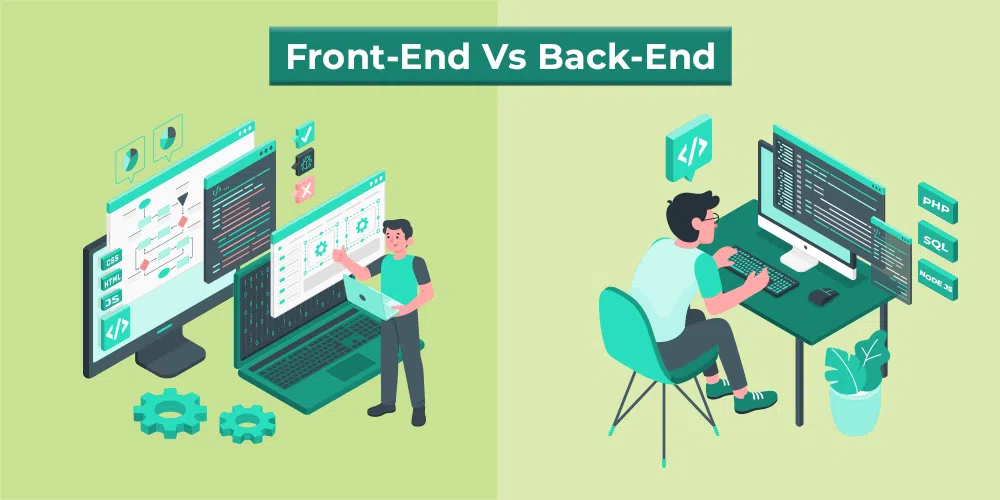When developing software applications, particularly websites, understanding the distinction between front-end and back-end development is essential. Both roles are crucial, yet they involve different skills, tools, and responsibilities. This article explores the key differences between front-end and back-end development and the tools developers use for each.
What Is Front-End Development?
Front-end development focuses on the user interface (UI) and user experience (UX) of a website or application. It involves designing and building everything the user interacts with directly, including layouts, colors, buttons, menus, and content presentation. The goal is to create visually appealing, intuitive, and responsive interfaces that ensure users have a seamless experience.
Key Responsibilities of a Front-End Developer:
- Designing the structure, look, and feel of the user interface.
- Ensuring cross-browser and cross-device compatibility.
- Developing responsive web pages that adapt to different screen sizes.
- Optimizing web performance for faster loading times.
- Collaborating with UX/UI designers to implement designs effectively.
Popular Tools and Technologies for Front-End Development:
- HTML (Hypertext Markup Language): Structures the content of web pages.
- CSS (Cascading Style Sheets): Controls the layout and appearance of elements.
- JavaScript: Adds interactivity and functionality to web pages.
- React.js: A JavaScript library for building user interfaces.
- Vue.js: A lightweight framework for building single-page applications (SPA).
- Angular: A TypeScript-based framework for building dynamic web apps.
- Bootstrap: A CSS framework for developing responsive web layouts.
- SASS/LESS: CSS preprocessors that allow for modular and reusable styles.
What Is Back-End Development?
Back-end development involves building and maintaining the server-side of an application. This includes managing the database, server, and application logic that power the front-end experience. Back-end developers ensure that data flows seamlessly between the front end, database, and server to deliver the expected results to users.
Key Responsibilities of a Back-End Developer:
- Designing and maintaining the architecture of servers and databases.
- Implementing APIs for front-end interaction.
- Ensuring data security and user authentication.
- Optimizing application performance and scalability.
- Debugging and fixing issues in server-side logic.
Popular Tools and Technologies for Back-End Development:
- Node.js: A JavaScript runtime for server-side development.
- Python (with Django or Flask): Popular frameworks for scalable back-end applications.
- PHP: A server-side scripting language commonly used with WordPress.
- Ruby on Rails: A framework for building web applications quickly.
- Java (Spring): Used for building enterprise-level back-end services.
- SQL/MySQL/PostgreSQL: Relational databases for managing data.
- MongoDB: A NoSQL database for flexible data structures.
- Docker/Kubernetes: Tools for containerization and orchestration.
Front-End vs Back-End: Key Differences
| Aspect | Front-End Development | Back-End Development |
|---|---|---|
| Focus | User interface and experience | Server-side logic and data management |
| Technologies Used | HTML, CSS, JavaScript, React, Bootstrap | Node.js, Python, PHP, SQL, MongoDB |
| Responsibility | Visual design, responsiveness, interactivity | Data handling, server logic, performance |
| Direct User Interaction | Yes | No |
| Examples | Building buttons, forms, and layouts | Managing databases, building APIs |
| Performance Concerns | Load time, UX performance | Data processing, server efficiency |
Full-Stack Development: Bridging the Gap
In recent years, full-stack developers have become increasingly popular. A full-stack developer has expertise in both front-end and back-end development, enabling them to build complete applications from start to finish. They can design user interfaces and manage databases and server logic, offering a more holistic approach to software development.
Collaboration Between Front-End and Back-End Developers
For a project to succeed, front-end and back-end developers must work together seamlessly. Here’s how they collaborate effectively:
- APIs: Back-end developers create APIs that allow front-end developers to access the necessary data.
- Version Control Systems: Tools like Git and platforms like GitHub or GitLab help both teams collaborate on code efficiently.
- Project Management Tools: Software like Jira or Trello helps track tasks and progress across teams.
- Regular Communication: Teams often hold regular meetings to align their work and ensure smooth integration between the front-end and back-end.
Conclusion
Both front-end and back-end development are essential to building functional and user-friendly software. While front-end development focuses on the visual elements that users interact with, back-end development ensures that the application functions correctly behind the scenes. Mastering both areas opens the door to full-stack development, a highly valued skill in the tech industry. Collaboration between these two disciplines ensures that projects are completed successfully and deliver an excellent user experience.
Whether you’re planning to specialize in front-end, back-end, or aspire to become a full-stack developer, understanding these roles will give you a well-rounded perspective on software development.


